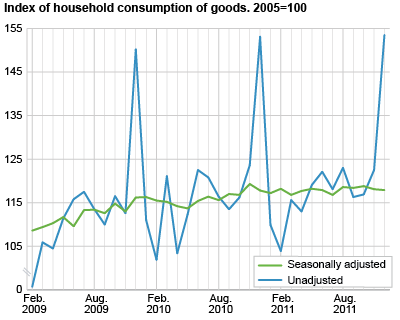Content
Published:
This is an archived release.
Stable household consumption
Seasonally-adjusted figures show that household consumption was down 0.1 per cent from November to December 2011, which followed a slightly larger decline the previous month. The groups of food and cars played a role in curbing the consumption of goods.
Consumption of food and beverages and tobacco decreased by 0.9 per cent in December, while purchases of vehicles, fuel and oil etc. decreased by 2 per cent.
Purchases of other goods, which include clothing, furniture and recreational equipment, however, went up by 1 per cent. In particular, clothing, sporting goods and electronic goods pulled up.
The consumption of electricity and fuel showed an increase of 1.9 per cent in December.
Without adjusting for seasonal variations, the household consumption of goods was 0.2 per cent higher in December 2011 than in December 2010.
| Period | Sesonally adjusted | Change from previous month. Per cent | Unadjusted | Change from the same month last year. Per cent | |||||||||||||||||||||||||||||||||||||||||||||||||||||||||||||||||||||||||||
|---|---|---|---|---|---|---|---|---|---|---|---|---|---|---|---|---|---|---|---|---|---|---|---|---|---|---|---|---|---|---|---|---|---|---|---|---|---|---|---|---|---|---|---|---|---|---|---|---|---|---|---|---|---|---|---|---|---|---|---|---|---|---|---|---|---|---|---|---|---|---|---|---|---|---|---|---|---|---|---|
| 2011 | |||||||||||||||||||||||||||||||||||||||||||||||||||||||||||||||||||||||||||||||
| December | 117.9 | -0.1 | 153.5 | 0.2 | |||||||||||||||||||||||||||||||||||||||||||||||||||||||||||||||||||||||||||
| November | 118.1 | -0.6 | 122.5 | -0.9 | |||||||||||||||||||||||||||||||||||||||||||||||||||||||||||||||||||||||||||
| October | 118.8 | 0.3 | 116.9 | 0.5 | |||||||||||||||||||||||||||||||||||||||||||||||||||||||||||||||||||||||||||
| September | 118.4 | -0.2 | 116.3 | 2.5 | |||||||||||||||||||||||||||||||||||||||||||||||||||||||||||||||||||||||||||
| August | 118.6 | 1.6 | 123.0 | 5.7 | |||||||||||||||||||||||||||||||||||||||||||||||||||||||||||||||||||||||||||
| July | 116.8 | -1.0 | 118.1 | -2.2 | |||||||||||||||||||||||||||||||||||||||||||||||||||||||||||||||||||||||||||
| June | 117.9 | -0.2 | 122.1 | -0.3 | |||||||||||||||||||||||||||||||||||||||||||||||||||||||||||||||||||||||||||
| May | 118.2 | 0.4 | 119.1 | 6.1 | |||||||||||||||||||||||||||||||||||||||||||||||||||||||||||||||||||||||||||
| April | 117.7 | 0.7 | 113.0 | 9.4 | |||||||||||||||||||||||||||||||||||||||||||||||||||||||||||||||||||||||||||
| March | 116.8 | -1.2 | 115.6 | -4.5 | |||||||||||||||||||||||||||||||||||||||||||||||||||||||||||||||||||||||||||
| February | 118.2 | 0.9 | 103.9 | 1.9 | |||||||||||||||||||||||||||||||||||||||||||||||||||||||||||||||||||||||||||
| January | 117.2 | -0.5 | 109.9 | -1.0 | |||||||||||||||||||||||||||||||||||||||||||||||||||||||||||||||||||||||||||
| 2010 | |||||||||||||||||||||||||||||||||||||||||||||||||||||||||||||||||||||||||||||||
| December | 117.8 | -1.3 | 153.1 | 1.9 | |||||||||||||||||||||||||||||||||||||||||||||||||||||||||||||||||||||||||||
| 1 | Please note that the indices have been revised. |
Method differs from the index of retail salesThe index of household consumption of goods describes the development in household consumption, while the index of retail sales measures the development in retail sales. Compared to the index of retail sales, the index of household consumption of goods has a wider selection of goods. The calculation of the index of household consumption of goods is based on information from the index of retail sales, plus purchases of cars (initial registration) and consumption of electricity and heating fuels. This may result in deviations in the development of the two indices. Additionally, it should be borne in mind that the Standard Industrial Classification changed on 1 January 2009, which inter alia means that petrol stations from then onwards are part of retail sales. |
Connection to quarterly national accountsThe index of household consumption of goods uses the same definitions and methods of compilation as the quarterly national accounts, and thus serves as an indicator of household consumption in the quarterly national accounts. |
RevisionsSince Statistics Norway gives a high priority to timeliness in the release of statistics, the index of household consumption of goods sometimes has to rely on preliminary estimates, which are replaced in subsequent releases. The national accounts have recently carried out a revision of the time series . The Index of household consumption of goods, which uses the same methods and definitions as the consumption calculations in the quarterly national accounts, is affected by this revision. Also, the reference year has been changed to 2005. |
Seasonally-adjusted figuresAs regards the seasonally-adjusted figures, the figures for previous periods may be revised when a new month is added to the series. For further information, see About seasonal adjustments in the left column. |
Contact
-
Vemund Rundberget
E-mail: uve@ssb.no
tel.: (+47) 97 65 50 90

